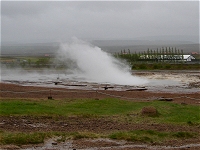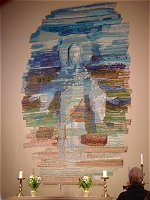|
Despite the stunning scenery,
our eyes were starting to close as we rode out to
our first stop at some sort of geothermal greenhouse/gift
shop called Eden. Both of us dosed during the ride,
so we weren’t really sure why we were there. We walked
around for a bit with our tourmates before being loaded
back on the bus. Our next stop was a little more interesting
as we visited the Kerith crater lake. By this time
it was already beginning to rain, but a short walk
in the cool weather started to bring us back to life.
Geologically speaking, Iceland is a happening place
with glaciers, waterfalls, volcanoes, geysers, and
hot springs – a land of fire and ice. Even before
you touch down, you can’t help but notice the basalt
rock that constitutes much of the island, the pumice
that impart a red color to the land, and the ground
fissures that seem to be almost everywhere. It all
gives Iceland an extraterrestrial look.
Our next stop was the bishopric
of Skálholt which was not only reported to
be Iceland’s largest town at one point, but it was
also the country’s cultural and religious center.
In the 12th century, a cathedral was constructed on
the site from timber that had to be imported from
Norway. When Iceland was settled in the 10th century,
about 30-40% of the land was covered with trees. Only
a few patches of birch trees now exist, but a large
reforestation program is underway. Today, a new church
stands on the same site but archeologists are actively
digging in and around the area. After another short
bus ride, we arrived at the stunning double water
fall of Gullfoss. We stayed just long enough to get
drenched by the rain and mist and to enjoy the gorgeous
views before reboarding the bus to visit the geothermal
fields at Geysir. Once there, we sauntered around
looking at bubbling hot pots and waiting for the geysers
(the word originated from this location) to spew.
Our final stop was the national
park of Thingvellir (or Þingvellir). Iceland
is bisected by the mid-Atlantic Ridge which means
that half of the country is on the Eurasian tectonic
plate and half on the North American plate. Most of
the ridge is deep in the Atlantic Ocean but it appears
on land in Iceland as a large rift. The rift and surrounding
park played a significant role in Icelandic history
since the first Viking settlement. Once a year at
Thingvellir (meaning "assembly plains"),
new laws and amendments would be read from the Loberg
or "law rock" to a group of leaders and
officials gathered below. This assembly, known as
the Althing, was the first European parliament and
continued successfully for nearly 900 years.
|

A geyser lets off some steam.

Portrait of Christ at Skálholt.

The Loberg at Thingvellir.
|